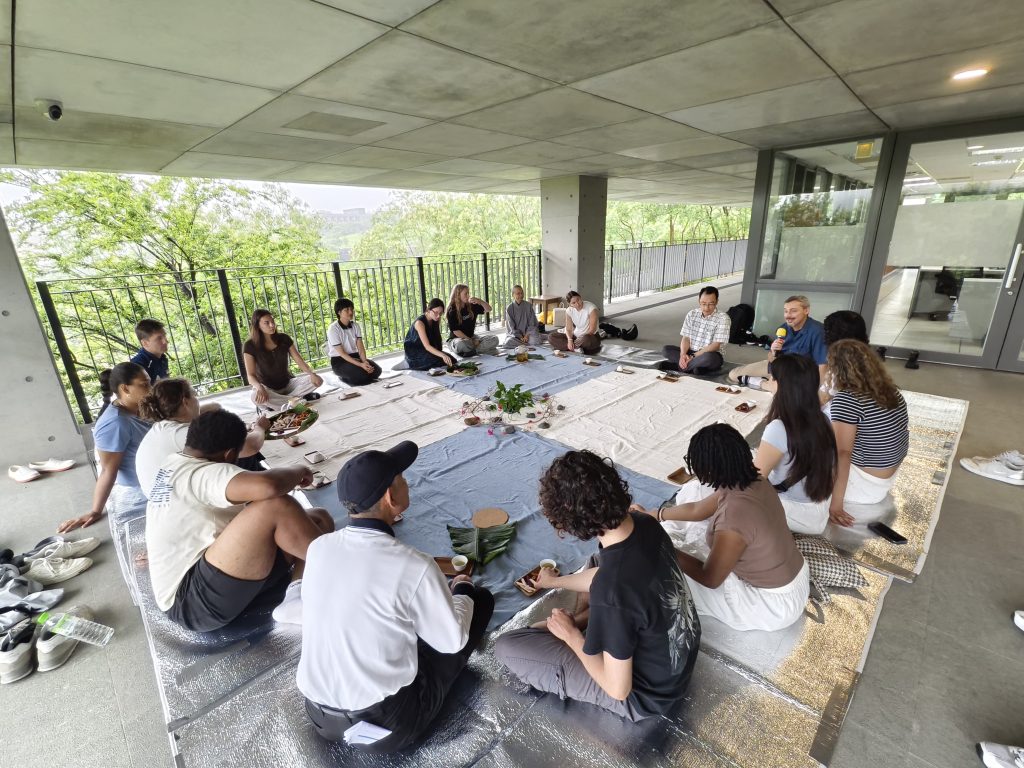This day was wholly focused on our visit to Dharma Drum Mountain, which we stayed at for about seven hours. I felt like this was going to be one of the biggest stretches out of our comfort zone, as the day would be filled primarily with meditation and lecture. However, I was looking forward to taking a break from furiously taking notes and having the excuse to put my phone away for a day. I also was excited to see even such a small glimpse into what a Buddhist monastic’s life is like at Dharma Drum Mountain and compare it to my experience in Fo Guang Shan.

We spent the better part of the morning learning different methods of meditation. After Enders (the man closest to the camera in the photo below) spoke a bit about what it is like as a student at the Dharma Drum Institute of Liberal Arts, we had a sitting meditation. We were very familiar with this, as Prof. Young has led us in a sitting meditation before every class, but this time we received more verbal guidance on breathing and doing a body scan. We were then provided umbrellas to do some slow walking out in the rain in which we focused on being out in nature and noticing all of our different sensations. Lastly, we went to a deck facing the forest and were asked to respond to nature now that we had listened to it. This consisted of some of the chanting people are familiar with: we spoke out some loud AAAAAs, OOOOOs, AAOOs and MMMMMs out into the world. At one point I was really feeling the vibrations in my chest, I don’t think I’ve vocalized at that frequency for so long before. It sounded pretty cool with all of us doing it simultaneously.
Afterwards, we took a snack break to discuss how we had felt about the morning and to express our thoughts on DILA or Buddhism in general. We were given a lotus herbal tea and got to try snacks like dried fruit (I’m not sure what it was but it was pretty good) and taro chips. Many of us had very similar thoughts about the benefits of meditation and how it made us more aware of the world. While listening to the rain, for instance, we were asked to not try to identify any of the sounds but to listen to the whole. As a result, I felt like I could hear the rain from much further away and I became more aware of all the birds. We then went to the cafeteria to have a vegetarian lunch. I liked the majority of it since I’m a fan of tofu and many of the dishes were spicy and/or had peppers in them. There was also a small coffee counter in an adjacent room where you could get a cup of black coffee in exchange for a donation of any amount. The coffee was also really good!

We passed over the bridge to enter a meditation hall for a lecture by Dr. Osborn. He was once a Buddhist monk for many years and before disrobing some number of years ago: he now has a family and continues to teach others about Buddhism. He flew threw a summary of the history of Buddhism in China and Taiwan, the rises and falls of its popularity and the changes made to different traditions. We spoke with some nuns from Dharma Drum afterwards to ask all the new questions we had after the lecture. I asked if there were any traditions that had changed that they can recall, and one mentioned that for meditation they used to do a sitting meditation and then get up and sprint. I can’t even imagine what that might have looked like, but I think that the current method is a lot more relaxing and mindful. I also learned more about splits between Buddhist idealogies, such as between Pure Land Buddhism and Chan (Zen) Buddhism, the latter of which is what we’d been learning more about at Dharma Drum. The first focuses more on a person’s death and what rites and rituals can be done to aid their successful delivery to the “Pure Land” after they’ve passed, whereas Chan Buddhism focuses more on what can be done for the living. In the lecture, he also touched on how Buddhism used to only be called upon for funeral rites, but from what I’ve seen it is a much more humanistic, every day practice in Taiwan today. This change likely contributes in part to the success of the three large Buddhist institutions in Taiwan.

This was a great last official visit that really helped culminate our religious education in Taiwan. It was very low key and relaxing despite the length, and we got to put into practice the things we’ve learned about meditation. I also was glad to ask nuns from a different institution similar questions that I asked at Fo Guang Shan to see how Buddhism has evolved to be more flexible and accepting of different practices.